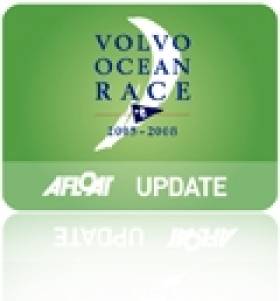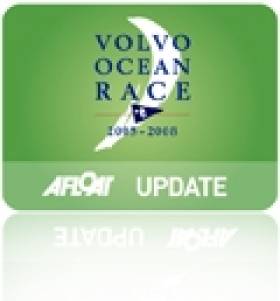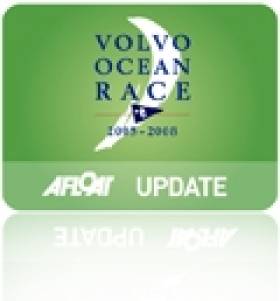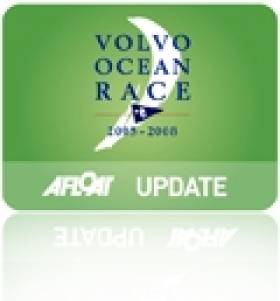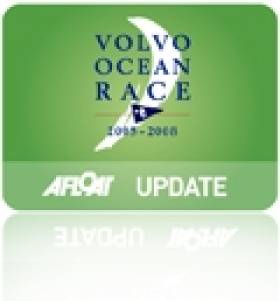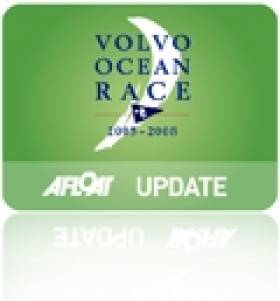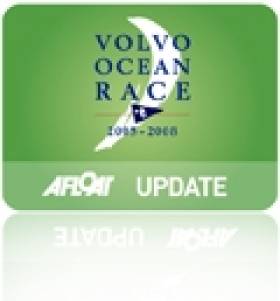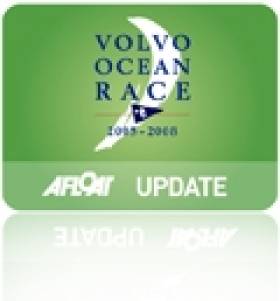Displaying items by tag: Volvo Ocean Race
Dongfeng VOR Leaders Bow Out of Southern Ocean
#vor – Dongfeng Race Team with Ireland's Damian Foxall onboard announced late last night that they plan to retire from Leg 5 of the Volvo Ocean Race after breaking their mast in the Southern Ocean. Skipper Charles Caudrelier had considered attempting to re-join the 6,776-nautical mile stage from Auckland to Itajaí after successfully nursing Dongfeng to Ushuaia, Argentina, earlier in the day.
But on Tuesday night, a statement from the team read: "The decision has been made to motor-sail to Itajaí and not rejoin the race – although skipper Caudrelier has yet to officially retire from the leg at this time, it is just a matter of protocol now.
"He will not relish this part of the administrative process and if there had been any other timely and effective way to rejoin the race and get to Brazil, he would have undoubtedly taken it.
"But even under motor-sail the delivery trip is expected to take around 10-12 days and then add the days needed to refit the boat in time for the start of Leg 6 to Newport.
"Trying to rejoin the race which would mean returning to the point they started using the engine at the western entrance of the (Beagle) Channel then sail south around Cape Horn would prove to be too risky, especially with rig and sails not fully fit for racing.
"It wasn't safe to enter the Beagle Channel without the engine, even if it would have left more options for a racing departure."
By motoring to Itajaí, they will buy some time to make the repairs ready to start Leg 6 to Newport - although it will still be tight. The fleet is due to depart on April 19.
Dongfeng Race Team plan to leave Ushuaia for Itajaí on Wednesday evening.
At 0315 on Monday, a sickening crack had signaled to Caudrelier and his crew that the top section of the mast had fractured, leaving the boat without full manoueverability.
The decision means that Dongfeng Race Team, who were joint leaders with Abu Dhabi Ocean Racing (Ian Walker/GBR) at the start of the leg, will collect eight points for a Did Not Finish result.
In the latest position report at 1840 UTC on Tuesday, Abu Dhabi Ocean Racing led by 8.8nm from Cape Horn pace-setters, Team Alvimedica (Charlie Enright/USA)
#vor – New dramatic footage of Damian Foxall's stricken Volvo Ocean Race men on the dismasted Dongfeng has emerged with crew man Kevin Escoffier up the mast cutting away the damage as the crew make the necessary sacrifices to stabilise the situation working to secure the mast before entering the Beagle Channel. There's frustration in the Southern Ocean for the Chinese team as Escoffier breaks his grinder while cutting the sail free and as darkness falls it's a race against time for the determined men of Dongfeng.
For the professional offshore sailors of the world, mast breakages (or any sort of damage to the boat) is an unfortunate occupational hazard. That's not to downplay the devastation and disappointment of what happened but for sailors like Damian Foxall, Charles Caudrelier, Martin Strömberg and even Pascal Bidégorry, dismasting in the Southern Ocean is an unfortunate case of déjà vu. These men have been there and done that.
For our rookie Chinese sailors on the other hand, the experience has been shocking, scary and bewildering. The reaction of Liu Xue (Black) is understandably in contrast to the pro crew who know how to manage these kinds of situations. Seen through his eyes, it is a heart wrenching reaction...
Liu Xue (Black): "Speechless, really speechless, I still can't believe this is true. You know one day, only one day we will have passed Cape Horn. Just one step and my dream will have come true, what a shame!"
"I thought a lot when the accident happened. What I wanted to do the most is to let my family to know that I'm safe. Because as the race is going and with more and more media coverage going out, my family started to know more about this leg. My mom was concerned about my safety a lot at some point. Actually there's nothing special, I know that I wouldn't be able to speak with them, I just would like them to know that I'm all good, that's it.
"I was sleeping below when the accident happened, I was shocked when I came on the deck. I have the feeling all the time that this is like in a movie. The 'scenes' of this leg is been played quickly in my brain. I'm not reconciled at all – the team worked closely and we fought so hard. And it's all gone in no time. Nothing left. We were only 240nm and 10 hours away from realising the dream.
"In this short 10 minutes, my dream has been crushed. We've been through so many suffering days before, we fought so hard just for this.
"Our skipper is surprisingly calm this time. He's too calm, we don't even have the feeling that he's just been through such frustration. Probably it's because he has his old mates Pascal, Damian and Martin onboard, and (their presence) gives him energy.
"The presence of Damian is the key of solving this problem. Because he's there, we were not in a panic. His makes us feel confident.
"Pascal is like a kind father this time. He came and touched Wolf's head and my head, comforting us 'it's going to be ok, we still have chance and time'. He even made a joke with me. He told me when he attempted to sail around the Cape Horn 14 years ago, the mast was also broken, and it took them 22 days to reach the Cape Horn after the damage happened, so we are actually lucky this time.
"Everyone's reaction after what happened made me feel warm and touched. Actually I didn't cry, I was just sad. But I wouldn't feel ashamed even if I cry, because the journey of this leg is marvellous. We are learning something new about the ocean every day, we respect the ocean, and also looking forward for the next challenge.
At the beginning of this project, managing expectations of our Chinese sponsors was key. This is ocean racing, something will happen, we have some very inexperienced sailors onboard we must take precautions. Then naturally when something like this happens, telling our partners is not easy. But the support from our partners has been outstanding and demonstrates their appreciation of what taking on the Volvo Ocean Race really means.
"We are sad to know the failure of the mast but happy to know all the team are safe. Please let Charles and his team know we are always with them, safety first, then try to repair the boat and get ready for next fighting!" Gary Huang, Vice President of Dongfeng Trucks.
Volvo Ocean Race Fleet Approach Cape Horn
#vor – The Volvo Ocean Race fleet, battered but unbroken as they battle through the Southern Ocean, face the toughest 48 hours of the nine-month marathon as they approach Cape Horn on Monday.
The region is the only time in the 38,738-nautical mile race where the boats are likely to see icebergs, despite the ice limits set by organisers, and a huge storm is building up behind to chase them on their way (see details here).
Early on Saturday (0640 UTC), the Chinese boat Dongfeng Race Team, skippered by Frenchman Charles Caudrelier, led the leg from Auckland to Itajaí, Brazil, but by less than 10nm from four other crews.
Caudrelier admitted that the stress has become "wearing' on his eight-man team.
"I think it's unique in the history of the Volvo Ocean Race (launched in 1973) to have a fleet battling like this in these latitudes," he wrote in his blog on Saturday.
"Tomorrow, we'll be even further south and the water temperature is going to drop. I'm expecting the hardest part of this race in the next 48 hours."
Dongfeng were one of three boats to crash over on their sides midway through the Southern Ocean on the 6,776nm leg – a so-called 'Chinese gybe'.
Thankfully, all the crews avoided anything more serious than cuts and bruises and damage to boats have been repaired on the move.
After some 3,000nm miles of sailing in the toughest leg of the race, Dongfeng lead by just 5.1nm from Dutch boat Team Brunel (Bouwe Bekking/NED) with overall leaders Abu Dhabi Ocean Racing (Ian Walker/GBR), MAPFRE (Iker Martínez/ESP) and Team Alvimedica (Charlie Enright/USA) no more than 4nm further adrift.
The all women's crew of Team SCA (Sam Davies/GBR) were nearly 100nm behind that pack, but gaining all the time in stronger winds.
They and MAPFRE also suffered Chinese gybes on Tuesday. The leg is expected to conclude around April 5-6 after three weeks of sailing from New Zealand.
In all, the boats will sail nine legs and visit 11 ports. They finish the race on June 27 in Gothenburg, Sweden.
#vor – The Volvo Ocean Race fleet reached the halfway point of their nine-month marathon – midway through the fifth leg of nine – on Friday and were still glued together in some of the closest racing in the event's 41-year history.
For those on shore, the day offered the chance to take stock following a dramatic week in which three boats suffered Chinese gybes, but for the crews it was business as usual as they tussled head-to-head approaching the key landmark of Cape Horn.
At 1240 UTC, just 7.7 nautical miles (nm) separated the first five boats with Team SCA (Sam Davies/GBR) bringing up the rear, some 80nm further adrift (see panel above).
Dongfeng Race Team (Charles Caudrelier/FRA) must think they are on some kind of Southern Ocean crazy rollercoaster.
On Tuesday, they were part of the trio of boats – MAPFRE (Iker Martínez/ESP) and Team SCA were the others – to crash over on their sides in a so-called Chinese gybe.
But, remarkably, all the crews managed to right themselves without overly serious damage to either sailor or boat and within 48 hours of the incidents, Dongfeng Race Team found themselves at the head of the fleet.
This was no time to take it easy, however, for anyone.
The 1240 UTC position report on Friday showed the Chinese boat had lost pressure again and slipped back to fifth place behind new leaders, MAPFRE, with Team Alvimedica (Charlie Enright/U.S.), Team Brunel (Bouwe Bekking/NED) and Abu Dhabi Ocean Racing (Ian Walker/GBR) sandwiched in between.
All was certainly not lost for Caudrelier and his crew, however, with MAPFRE virtually within view.
For Dongfeng's helmsman, Damian Foxall (IRL), it has already been a memorable ride, after being called up to sail just this 6,779nm leg.
"It is hard to describe the stress on board after the Chinese gybe – 'is everyone here, is anything damaged?' Yet three hours later, incredibly, we were back on track," he wrote in a blog.
Sam Davies, skipper of Team SCA, was also in a reflective mood early on Friday.
"It has been a hard few days; full of emotion, stress, adrenaline," she wrote in her blog.
"As skipper it is hard to find the balance between pushing the boat and crew, but making sure we stay safe and keeping our boat in one piece.
"Out here, there is little margin for error. I feel like we have found our limits, and proved to ourselves that we are pushing hard.
"We suffered from our wipeout with the damage we sustained and it is frustrating to lose the miles like that, but we are slowly getting back to as near 100 per cent as possible."
The fleet is expected to reach Cape Horn on Sunday, and then their Leg 5 destination, Itajaí in south-eastern Brazil, around April 4.
The race, with four and a half legs still to negotiate and six more ports to visit, remains too close to call, with the two overall leaders, Abu Dhabi Ocean Racing and Dongfeng Race Team, fighting it on a level eight points apiece, and currently just 4.8nm apart.
Welcome to one-design racing!
Volvo Ocean Race Yacht Chinese Gybe Video
#chinesegybe – This frightening video of a 'chinese gybe' was taken early this week on board a yacht taking part in the round-the-world Volvo Ocean race, as it encountered rough weather in the tumultuous Southern Ocean. The MAPFRE team's vessel did an involuntary "Chinese gybe," also known as a "death roll," while located about 2,000 miles from the nearest landmass. Two other teams did Chinese gybes on Monday into Tuesday in gale force winds and high seas, causing damage to some of the boats but no injuries.
MAPFRE (Iker Martínez/ESP), pictured above, led the fleet over Point Nemo on Wednesday after an amazing recovery from their Chinese gybe just 24 hours earlier.
They were one of three boats – Dongfeng Race Team (Charles Caudrelier/FRA) and Team SCA (Sam Davies/GBR) were the others – to crash over on their side as the fleet struggled through a heinous sea state and 40 knots of wind (75kph) in the Southern Ocean.
#vor – Four of the six Volvo Ocean Race boats suffered big hits as the Southern Ocean gave the fleet its roughest ride of the race in 12 dramatic hours.
Team SCA (Sam Davies/GBR), Dongfeng Race Team (Charles Caudrelier/FRA) and MAPFRE (Iker Martínez/ESP) did Chinese gybes* from Monday to Tuesday but all three crews escaped injury despite the boats toppling over.
Damage was still being assessed in the aftermath of the incidents although Dongfeng Race Team appeared to have avoided any serious problems with the boat.
Abu Dhabi Ocean Racing (Ian Walker/GBR) also endured a drama-filled night, reporting a "night of two gybes: a wild one in pitch black with a massive wipe-out and then a 'controlled' one at 30 knots".
Dongfeng Race Team were first to reveal a Chinese gybe, with their Onboard Reporter Yann Riou (FRA) reporting: "It took two to three hours to sort out the mess, the boat was on her side, we took 300 litres of water in to the boat through an air vent."
Then Team SCA were similarly upended at around 0500 UTC, the all-women team's Onboard Reporter, Anna-Lena Elled (SWE), reported.
"We ended up on the side for maybe two to four minutes before slowly getting back in the right position," she told Race HQ.
The crew was assessing the damage and already starting to effect some repairs, Elled continued.
MAPFRE (Iker Martínez/ESP) also reported a third Chinese gybe, which happened around 2000 UTC. There was no immediate news from the Spanish boat regarding damage.
All four boats were still able to continue sailing.
The Emirati boat still recovered to move within eight nautical miles (nm) of leaders Team Brunel (Bouwe Bekking/NED) with MAPFRE in third, 26nm further adrift. Team SCA lost 38nm with their struggles to fall 97.9nm behind the leaders.
IN THE WAKE OF OUR CHINESE GYBE
"This is the first Chinese gybe experience in my life, I can still feel the fear when I think about it!" – Liu Xue (Black)
"That will be a great and amusing story to share over a beer in Itajai, or to my grandchildren in a few years time – but last night it was hell!" – Charles Caudrelier
Last night we experienced our first Chinese Gybe. To explain to you what this is we have two contrasting pieces of writing. One from Rookie Chinese sailor Liu Xue (Black) and one from our Skipper Charles Caudrelier. Both make for a very interesting read:
Black's blog
This is the first Chinese gybe experience in my life, I can still feel the fear when I think about! We were about to do a manoeuvre, but before we managed to start it, we were attacked by 2 huge waves. Holy crap, the waves were so huge and we were suddenly pushed right over on to our side. My brain went blank when that happened. I grabbed hold of the first thing I could – the sailor's instinct. It felt like I was on the Titanic when that happened, (I kept thinking) no, it's going to be bad.
But I calmed down quickly. I knew we have to avoid going overboard when a Chinese gybe happens, and that would be the scariest thing. But luckily we had only just come up on deck, and the boom didn't hit any one when it crashed across the boat, otherwise there would have been blood onboard now. Wolf and I were quite astonished, firstly because we've never experienced this before, and second it was happening during the night. But everyone was quite calm, no one was screaming or yelling. We tried to find the highest point (to stay on the boat), to make sure we were safe and then to find the solution to get out of it.
We didn't talk about it too much afterwards, the wind will be strong in the next few days, we rather save some energy (to fight with the wind and the waves) than keep talking. Wolf and I had a chat today, we both agree that the Chinese gybe that happened to the boat is a valuable experience for us. But hopefully it's not going to happen that often, otherwise I'm not sure if my heart is strong enough (laugh).
The wind and waves are very strong now, and I couldn't help throwing up again. People don't have much appetite when they don't feel comfortable. However, it's way too cold now and I had to force myself to eat something. At worse, I can still throw up after eating, but we really need calories and energy to fight against the horrible weather. It's freezing cold on the deck now, I keep trembling. It feels better when you go back to the cabin.
Despite the fact that is super bumpy, we sleep very deep, so you understand how tired we are. When we are off duty, we fall asleep in no time. I remember there was once when I was sleeping, my body was lifted up by the waves, then smashed back on to the bunk, but I fell asleep in no time again. No matter how bumpy it is, it doesn't affect us at all, we don't have any problem to fall asleep.
We haven't reached the Cape Horn yet, but it has already brought us so many challenges. Yesterday we were saying it's not as difficult as we thought, and then this all happened. How many challenges we will have to overcome in the future is unpredictable. Come on Southern Ocean, bring it on!
Caudrelier's blog
Chinese gybe
That will be a great and amusing story to share over a beer in Itajai, or to my grandchildren in a few years time – but last night it was hell!
Laid flat on the water [boat heeled at 90 degrees] at 48 degrees South, with 40 knots of wind and 5 metre seas is really not fun at all.
Bizarrely however in this position its very calm and quiet onboard, no more noise from the speed of the boat, its wake or the waves. A silence that allowed us to easily communicate between us to get out of it!
We paid a heavy price in terms of miles lost to our competitors [about 30], but I confess that despite that I am a happy skipper even after the incident. Why?
All my men are onboard, the crew did an extraordinary job, and we haven't broken anything, or damaged any sails.
A miracle.
So we really have started this leg badly, and we're making way too many errors. To win you have to make less errors than the others, and we've already used up our allowance in the first 6 days – there is still a long way to go! Now we are going to concentrate on doing a better job – promise!
#vor – Volvo Ocean Race's six-strong fleet finally headed out of Auckland this morning after the Leg 5 departure was delayed 67 hours to avoid the worst of Cyclone Pam.
However, the crews, led out of the 'City of Sails' by Dongfeng Race Team (Charles Caudrelier/FRA), knew they may have avoided the deadly weather system, but still face the toughest of all nine legs as they race through the notorious Southern Ocean.
"The conditions will be light early on, with coastal sailing up to East Cape (the tip of New Zealand), but after a few days it will be the full-on Southern Ocean regime," said the race's official meteorologist, Gonzalo Infante, shortly before departure at 0900 NZ time (2100 Tuesday CET).
"From then, the boats will be facing 25-35 knots of wind (46-65 kilometres per hour) for much of the time until they round Cape Horn."
Cyclone Pam, which forced the postponement from Sunday until Wednesday having wrought havoc in the South Pacific and causing at least 11 deaths on Vanuatu, will no longer be a major factor for the fleet, added Infante.
Leg 5, the Southern Ocean leg, from Auckland to Itajaí in south eastern Brazil, is 6,776 nautical miles (nm) long, will take roughly three weeks to complete, and is one major reason why many of the sailors in the fleet are competing in the Volvo Ocean Race.
The route takes the boats close to Point Nemo, the remotest place from land, in the South Pacific where the nearest humanity can be found in the space stations patrolling the earth.
It will also take the fleet back into the Atlantic for the closing stages of the leg for the first time since November, but, memorably for most, they will pass Cape Horn in the Southern Ocean on the tip of South America.
Ever since the 17th century when it was first regularly navigated by trade shipping, Cape Horn has been an iconic landmark for all sailors although it has claimed many victims over the years.
More people have reached the summit of Everest than sailed around Cape Horn. Waves can reach up to 30 metres (100 feet), roughly the length of a Volvo Ocean 65 mast, and the only company the sailors have will be albatrosses.
Many see the leg as a key staging post in the overall race. Simon Fisher (GBR), navigator for current leaders Abu Dhabi Ocean Racing (Ian Walker/GBR), summed up: "There's nowhere else on earth where you can do so much fast downwind sailing for so long," he said.
"It's going to be the first time the whole fleet sees a lot of wind for an extended period and it might shuffle the pack. Keeping in one piece all the way to the Horn is important, because that's where the race will be won and lost."
The same leg caused havoc to the fleet in the last edition in 2011-12 with only winners Puma escaping serious damage and eventual event victors Groupama limping home with a jury rig.
Nevertheless, so many hardened Volvo Ocean Race sailors keep coming back for more with the massively experienced Stu Bannatyne (NZL) and Damian Foxall (IRE) being recruited for this leg by Team Alvimedica (Charlie Enright/USA) and Dongfeng Race Team respectively.
Bannatyne, a six-time race veteran, did not need much persuading, it seems. "This," he said, "is the best sailing in the world."
Abu Dhabi Ocean Racing started the stage level on eight points with Dongfeng Race Team, but are race leaders courtesy of their superior in-port series record.
They are trailed by Team Brunel (Bouwe Bekking/NED) on 14 points, Team Alvimedica and Leg 4 victors MAPFRE (Iker Martínez/ESP) on 16, and New Zealand Herald Auckland In-Port Race winners Team SCA (Sam Davies/GBR) on 24.
The boats are expected to arrive in Itajaí around April 7.
Volvo Ocean Race to Restart on Wednesday After Auckland Cyclone
#vor – Following latest information on the development of Cyclone Pam, Volvo Ocean Race organisers have announced that Leg 5 from Auckland, New Zealand to Itajaí, Brazil, will now start on Wednesday, 18 March at 09:00 NZDT (Tuesday 17 March, 20:00 UTC, full story below).
"We see a significant change between leaving Tuesday afternoon and Wednesday morning in easier conditions, and this was also the preference of the majority of the teams," commented Volvo Ocean Race CEO Knut Frostad, coming straight out of a meeting with the six teams' skippers, navigators and weather experts in Auckland.
The fleet is now leaving on Wednesday instead of last Sunday as initially planned.
"The cyclone is still a very severe system near New Zealand. Most of the routes on this leg take you very close to that cyclone for a substantially long period of time.
"Now that we have started delaying because of the cyclone, it's always a matter of when do you leave, when do you feel that it's far enough away? What we see is that the system is big, it's not moved very far, and leaving on Tuesday they'd very quickly be into 40 knots and a very big sea state."
"There's probably not many people who have sailed very close to a cyclone," commented Team SCA's navigator Libby Greenhalgh. The winner of The New Zealand Herald In-Port Race Auckland on Saturday agrees with this decision.
"On Tuesday, we would be in 35 to 40 knots for between five and seven days, whereas Wednesday that's not the case. We still end up catching it up but the storm has started to decay. It's probably going to be significantly different even though that's difficult to estimate and easy to underestimate as well.
"It's not been easy for Volvo Ocean Race to decide but they've listened and everyone has had their opportunity to put forward what they feel, and I think they've taken a reasonable stab at it. For us we're happy, we're pleased."
"We had a discussion about whether we should start on Tuesday or Wednesday morning," said Abu Dhabi Ocean Racing's skipper Ian Walker.
"Four of the six teams very strongly felt that we should leave on Wednesday, so the organisers decided that we should leave at 09:00 Wednesday morning."
Now less than 48 hours to the start of this 6,776-nautical mile stage across the Southern Ocean and around Cape Horn, Frostad also put things into perspective, reminding the fleet of the actual impact of Tropical Cyclone Pam in the Pacific region.
"This is a cyclone which has killed many people, and created a total disaster in some amazing islands that we just raced through north of New Zealand.
"It's not just a weather system, we're talking about a natural disaster. For me, as a race organiser, I would never even consider starting in that cyclone.
"We know that the system is still out there. We have enough wind readings to know that it's still strong. There are times when you just simply have to wave the safety flag."
Estimated Time of Arrival in Brazil:
The initial range of ETAs in Itajaí was from April 1 - 5, 2015. However, this is now likely to be delayed and at this stage there are still too many uncertainties in the forecast to establish a clearer range.
Team SCA Take Second VOR In-Port Race Victory Of The Year
#VOR - They may be training behind the pack on the race legs, but the women of Team SCA flexed their muscle in Auckland, New Zealand a few hours ago to take their second in-port race victory of the 2014-15 Volvo Ocean Race.
And as the VOR website reports, it was a convincing victory at that, as they look the lead from the start line and held position through the course that took the fleet under the Auckland Harbour Bridge.
Team skipper Sam Davies said the win would "boost our team's morale for the next few days" as the six-boat fleet awaits the passing of Tropical Cyclone Sam before they can safely embark on the voyage across the Southern Ocean to South America and Itajai in Brazil - the longest leg of the race by far at some 6,776 nautical miles.
The win marks the all-female team's biggest highlight of the VOR since their New Year in-port race first place in Abu Dhabi.
Volvo Ocean Race Leg 5 Start Postponement
#vor – Due to Tropical Cyclone Pam, Volvo Ocean Race organisers have decided that the Volvo Ocean 65 boats will not leave Auckland for Itajaí earlier than 14:00 NZ time / 01:00 UTC on Monday March 16.
A final decision will be made and communicated no later than 12:00 NZDT on Friday March 13 (23:00 UTC on Thursday 12 March) on whether the delay will be to 14:00 NZ time on Monday March 16 or later.
The communication will also include Sunday's revised event programme.
The official skippers press conference will be held tomorrow Friday March 13, with the six team skippers in Auckland's Viaduct Events Centre. There will be an opportunity to enquire on the revised Leg 5 start plans tomorrow at 15:00 during the media session with CEO Knut Frostad.
The six-strong fleet was originally set to depart for the 6,776 nautical-mile voyage through the treacherous waters of the Southern Ocean on Sunday March 15.
But with forecasts suggesting that a grade five tropical cyclone could hit the area hard, Race organisers have taken the prudent step of delaying their exit by at least 24 hours.
As a result, the earliest possible restart would take place on Monday March 16 at 1400 local NZ time, although this is yet to be confirmed.
"Safety first," said Volvo Ocean Race CEO Knut Frostad today. "We're making this decision now because we don't know the exact track of this tropical cyclone yet.
"It's unusually big and essentially it's blocking the road for our sailors, so it's prudent seamanship from our side to leave them with options."
The current forecasts suggest that the tropical cyclone, which has already racked up winds of 200km/hr and has been named 'Pam' by experts, could strengthen further as it heads south.
And even if the system misses New Zealand, big swells and rough seas could still cause real problems for the fleet.
"Our biggest concern is the sea state, rather than the wind," continued Frostad. "The boats can handle a lot of wind, but there will be very big waves along the New Zealand coast, with nowhere to hide.
"We are not going to have the boats leaving Auckland before 1400 local time on Monday, but it could also be later. It depends completely on the movement of this tropical cyclone."
The New Zealand Herald In-Port Race Auckland, which begins at 1400 local time on Saturday 14 March, will still go ahead as planned.
Current forecasts predict perfect sailing conditions of 20kts of easterly breeze and warm sunshine to ensure that Saturday's sprint around the bay will be a spectacular event.
Grant Calder, General Manager of the Auckland stopover, said: "Saturday promises to be a great day out, both on the water and in Auckland's viaduct.
"The boats will be racing, and the Race Village will continue to offer a wide-range of free activities for everyone who wants to enjoy the last weekend of the 2014-15 Volvo Ocean Race Auckland stopover.
"We have some fantastic live entertainment lined up, including the Black Seeds on Saturday evening."
Despite the delay, a full departure ceremony including a mayoral handover and sailor's parade will go ahead as planned on Sunday.
Race organisers are tracking the cyclone's development and a revised event schedule for Sunday, including confirmation of whether any sailing will take place, will be issued as the situation develops.
The official skippers press conference will be held tomorrow Friday March 13, with the six team skippers in Auckland's ANZ Viaduct Events Centre.
There will be an opportunity to enquire on the revised Leg 5 start plans tomorrow at 15:00 in the ANZ Viaduct Events Centre during the media session with Volvo Ocean Race CEO Knut Frostad.


























